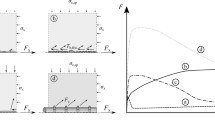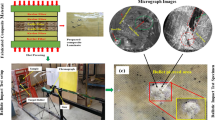Abstract
The reference modulus of bituminous mixes, used for road design in France, is determined by the complex modulus measurement, carried out in the frequency domain at 15°C, 10 Hz or by the secant modulus in direct tension at 15°C, 0.02 s. However, there is strong interest to access this modulus using the indirect tensile (IT) test carried out in the time domain. Actually, this test appears to be easier to implement due to the sample manufacturing and numerous laboratories are already equipped. The present study proposes to determine the experimental condition to be applied to the IT test in order to get the reference modulus. A theoretical approach, based on the Maxwell and Huet viscoelastic linear models, is used to find the testing conditions at which the IT test has to be performed to give as precisely as possible the reference modulus. This procedure is applied on a large database of materials for which the viscoelastic spectrum has been provided. The influence of the loading waveform, which cannot be systematically controlled, is studied. For a force increasing linearly with time, the temperature at which the IT test has to be performed is close to 10°C, whatever the bituminous mix type. Moreover, the error that would have been committed by applying the equivalent temperature Teq = 10°C during the indirect tensile test is evaluated. This error depends on the loading waveform but always remains, theoretically, under 1000 MPa. This study has been carried out in the framework of collaboration between LCPC and USIRF (Union des Syndicats de l’Industrie Routière française).





Similar content being viewed by others
Notes
This order condition regarding h and k serves to remove any ambiguity over the definition of δ, which thus affects the parabolic damper of the smallest exponent.
\( \Upgamma (x) = \int_{0}^{ + \infty } {u^{x - 1} e^{ - u} du} \)
References
Chailleux E, de La Roche C, Piau J-M (2009) Modeling of complex modulus of bituminous mixtures measured in tension/compression to estimate secant modulus in indirect tensile test (submitted to M&S)
Ferry J-D (1980) Viscoelastic properties of polymers. Wiley, New York
Hammoum F, Chailleux E, Nguyen H-N, Erhlacher A, Piau J-M, Bodin D (2008) Experimental and numerical analysis of crack initiation and growth in thin film of bitumen. Road Mater Pavement Des 10(1/2009):39–61
Huet C (1963) Etude par une méthode d’impédance du comportement viscoélastique des matériaux hydrocarbonés, Thesis, faculté des sciences de l’université de Paris (in French)
Nunn ME, Smith TM (1997) Improvements to the indirect tensile stiffness modulus test. In: TRL Paper PA 3209/96, 2nd European conference on performance and durability of bituminous materials, 17–18 April 1997
Tschoegl NW (1989) The phenomenological theory of linear viscoelastic behaviour. An introduction. Springer-Verlag, Heidelberg, pp 143–145
Acknowledgments
The authors would like to acknowledge MM Triquigneaux J-P, Carbonneau X, Pouteau B, Loup F and Dayde R who have actively participated to this study through the funding of USIRF (Union des Syndicats de l’Industrie Routière française).
Author information
Authors and Affiliations
Corresponding author
Appendices
Appendices
1.1 Appendix 1: Calculation of the secant modulus in indirect tension for a viscoelastic material that satisfies Huet’s model
Let’s begin by examining the theoretical response of a viscoelastic material that complies with Huet’s model, during a secant modulus test conducted in indirect tension.
Let’s assume the loading law defined by: \( F(t) = F^\circ \left( {{\frac{t}{{t_{ \max } }}}} \right)^{m} \), with m situated between 0 and 2. The associated load factor is expressed as: \( f_{\text{c}} = {\frac{1}{1 + m}} \).
By assuming a constant Poisson’s ratio for the material, the correspondence principle then indicates that during such a test, the stress field σ(x, t) located inside the specimen would be factorized in both space and time in the following form:
with σ°(x) = static elastic field associated with force F° and a Young’s modulus value equal to one.
The material thus exhibits the same secant modulus S(t) at all times and at every point of the specimen. This modulus value could be derived by simply evaluating the one-dimensional “stress–strain” relation for a stress level that satisfies the evolution law:
1.1.1 Calculation of S(t)
Let F(t) be the material creep function under the general case conditions. The strain ɛ(t) associated with stress history σ(t) is then given by the convolution law:
Substituting for the case of t = t max:
1.1.2 Application to Huet’s model
As a reminder, Huet’s model in association with a constant Poisson’s ratio serves to accurately describe the viscoelastic behavior of asphalt mixes. Its expression in terms of complex modulus can be written as follows:
with:
-
E∞ is the elastic modulus at infinite frequency,
-
h, k are exponents whose values lie between 0 and 1, such that h > k,Footnote 1
-
δ is positive and real,
-
τ(θ) is the temperature translation function.
Within the temporal domain, the creep function is equivalently associated with Huet’s model, i.e.:
with Γ(x) being the Gamma function.Footnote 2
This equation then leads to:
1.2 Appendix 2: temperature equivalence condition required to satisfy the secant and complex moduli equality
One of the parameters used in France to characterize asphalt mix stiffness is the complex modulus value at 15°C and 10 Hz.
By denoting f ref = 10 Hz, θ ref = 15°C, τ ref = τ(θ ref) and E*ref = E*(2πf ref τ ref), the following is obtained for Huet’s model:
At this point, it becomes possible to determine, for a given material, the theoretical temperature θ at which the indirect tensile test is to be performed in order to derive a secant modulus directly at the reference modulus.
The equation to be solved can then be written as: \( {\frac{1}{{S(t_{ \max } /\tau (\theta ))}}} = {\frac{1}{{\left| {E*_{\text{ref}} } \right|}}} \), yielding:
In practical terms, the solution value to this equation τ = τ(θ) is sought first, then θ can be obtained by inverting the relation between τ and θ.
The solution to the previous integral equation is based on the numerical calculation of both sides of the equality. The right-hand term causes no special difficulty.
As for the numerical calculation of the left-hand integral, let’s set:
and carry out the variable change: u = t max x.
Then: \( I(\tau ) = m\int_{0}^{1} {\left( {1 + \delta {\frac{{\left( {{\frac{{t_{ \max } }}{\tau }}x} \right)^{k} }}{\Upgamma (k + 1)}} + {\frac{{\left( {{\frac{{t_{ \max } }}{\tau }}x} \right)^{h} }}{\Upgamma (h + 1)}}} \right)(1 - x)^{m - 1} } {\text{d}}x \)
We now have:
\( \begin{gathered} I(\tau ) = m\int_{0}^{1} {\left[ {\left( {1 + \delta {\frac{{\left( {{\frac{{t_{ \max } }}{\tau }}x} \right)^{k} }}{\Upgamma (k + 1)}} + {\frac{{\left( {{\frac{{t_{ \max } }}{{\tau^{\prime}}}}x} \right)^{h} }}{\Upgamma (h + 1)}}} \right) - \left( {1 + \delta {\frac{{\left( {{\frac{{t_{ \max } }}{\tau }}} \right)^{k} }}{\Upgamma (k + 1)}} + {\frac{{\left( {{\frac{{t_{ \max } }}{\tau }}} \right)^{h} }}{\Upgamma (h + 1)}}} \right)} \right](1 - x)^{m - 1} } {\text{d}}x + \hfill \\ \left( {1 + \delta {\frac{{\left( {{\frac{{t_{ \max } }}{\tau }}} \right)^{k} }}{\Upgamma (k + 1)}} + {\frac{{\left( {{\frac{{t_{ \max } }}{\tau }}} \right)^{h} }}{\Upgamma (h + 1)}}} \right)\left[ { - (1 - x)^{m} } \right]_{0}^{1} \hfill \\ \end{gathered} \)which leads to:
The integrals contained in this expression feature the advantage of being easily numerically integrated over the [0, 1] interval by means, for example, of the trapezoidal method.
Note: For x tending towards 1, the integrand of the form \( {\frac{{1 - x^{p} }}{{(1 - x)^{1 - m} }}} \) tends towards 0 (see discussion below). Its value at this point can thus be directly set equal to 0, according to the numerical integration methods using the function value for the bound x = 1.
Let’s now set: x = 1 − ɛ
Then: x p ≈ 1 − p and thus: \( {\frac{{1 - x^{p} }}{{(1 - x)^{1 - m} }}} \approx {\frac{p\varepsilon }{{\varepsilon^{1 - m} }}} = p\varepsilon^{m} \to 0 \).
Ultimately, the equation in τ to be solved can be expressed as:
This equation can be solved using, for example, Newton’s iterative algorithm by calculating the numerical derivative of the first member I(τ) with respect to the variable τ. The following approximation enables initializing the algorithm at a value close to the solution point:
Glossary
- C ref1 et C ref2
-
Coefficient of WLF law for a reference temperature of T ref
- |z*|
-
Complex number modulus z
- E* = E1 + iE2
-
Complex stiffness modulus
- J(t)
-
Creep modulus
- E inf
-
E*(ω → ∞)
- F
-
Force (N)
- f
-
Frequency (Hz)
- Γ
-
Gamma function \( \Upgamma (x) = \int_{0}^{ + \infty } {u^{x - 1} e^{ - u} du} \)
- E0, E i , τ i
-
Parameters of generalized Maxwell model
- δ, k, h
-
Parameters of Huet model
- δ
-
Phase angle (° or rad)
- ω = 1/2πf
-
Pulsation (rad/s)
- ν
-
Poisson’s ratio
- E(t)
-
Relaxation modulus
- ε
-
Strain
- σ
-
Stress
- T
-
Temperature (°C)
- t
-
Time (s)
- a T (T1, T2)
-
Translation coefficient between isotherms T 1 and T 2 written as a function of log(ω). The coefficient aT is defined as follows:
E*(T 1 ,ω) = E*(T2,a T (T 1 ,T2)ω)
In particular a T (T 2, T 2) = 1
- z
-
Variation in disk diameter during indirect tensile test (m)
Rights and permissions
About this article
Cite this article
Chailleux, E., de La Roche, C. & Piau, JM. Study of the influence of experimental conditions applied to the indirect tensile test versus type of bituminous mixture. Mater Struct 44, 719–734 (2011). https://doi.org/10.1617/s11527-010-9661-1
Received:
Accepted:
Published:
Issue Date:
DOI: https://doi.org/10.1617/s11527-010-9661-1




